Guessing currency directions makes most people look like fools.
Some people – analysts – have currency forecasting as part of their job descriptions. I imagine they hate that part of their jobs.
There’s one happy factor in the world of currency forecasting: trends go on for a long time when they get going. A famous currency exchange rate analyst I was listening to last week noted that fact, plus the reality that most currency surges go on far past when one would imagine they would end based on fundamentals. That’s helpful for those analysts who are like my pet miniature Schnauzer Asta.
Read Also

Higher farmland taxes for investors could solve two problems
The highest education and health care land tax would be for landlords, including investment companies, with no family ties to the land.
Asta always wants to be in the lead on dog walks or at the dog park. And he’s very successful. Here’s the Asta Key To Leadership: Figure out which way everyone’s going to go anyway, and rush to get out in front. He’s brilliant at it: if he takes the wrong fork in the road in the forest, and the rest of us take the other one, he will whip around and come rocketing around the corner and barrel over our other dog, Wiggie, and blast through our legs or whatever else is in the way and get back out in front, ahead of everyone. Then, looking confident, he can once more show all the other dog walkers that he is the one leading, and we’re all following. The key to this sort of leadership is quickly recognizing when you’ve taken the wrong fork in the road, and then to rush out front, and then show absolutely no shame or sign of the fact that you were dead wrong a few seconds ago.
This leadership role was well-played by a big bank economist I heard on the radio a couple of months ago explaining why the Loonie would very soon be at 1-to-1 parity with the U.S. dollar. A month or so ago the same radio program had this big bank economist back on to explain why he now felt the Canadian dollar would slump in relative value and the Greenback would surge for an extended period. He didn’t sound chastened or contrite. Just confident about his new 180-degree turn of analysis. That qualifies him for the Asta, the award I’m going to start giving out for shameless reversals of opinion by wrongheaded prognosticators.
So how do you figure out a likely currency’s direction? You can rely on the fundamentals, but – as with the trend noted above – currencies often ignore the supposed fundamentals and go on trending. Or reverse course just when your primitive fundamental analysis told you that it would go on and on and on anon. And what are the fundamentals? That’s a tough one, because all currency interrelationships are precisely that: inter-relationships between different currencies. So, sure, right now the U.S. economy is still in the toilet and the U.S. fiscal situation is getting scarier by the day and there are all sorts of reasons to bail out of the Greenback. But into what? The Euro? How are the fundamentals there? Greece stumbling into the poorhouse, Italy, Portugal, Spain and maybe even my beloved U.K. perhaps following soon, the restrictions of the Eurozone meaning member governments don’t have devaluation and fiscal flexibility: see any reasons there to favour that currency over the Greenback?
Yes, there are the baby currencies, like the Canadian dollar, the Australian dollar, etc. out there, but they’re too small for most investors to feel safe with. The Chinese currency is not a direct option. The Japanese Yen is just kind of weird. Altogether it’s hard to come up with a simple strong-versus-weak scoresheet for the world’s major currencies these days.
Some of the hog industry’s haters have been running around in the past year saying that hog farmers should have seen their problems coming because they built the industry on a “low Canadian dollar.” Really? Were they saying this when the dollar was at 65 cents, or were they saying that it was going a lot lower? Remember all that “northern Peso” talk among prognosticators a few years ago? Remember the projections for a 50 cent dollar? Remember a certain big bank economist urging Canada to ditch the Loonie and embrace the Greenback before the Loonie dragged Canada into the gutter? I do. I didn’t hear too many calling for a massive revaluation of the Loonie like we’ve seen.
Was the hog industry built on a low dollar? At the time most would have said the dollar was overpriced, if anything. Farmers who made decisions based on what the most quoted analysts were saying were being pretty conservative, if anything. All the present talk about the hog industry being built on a low Canadian dollar assumes that there’s some sort of eternal rule by why the Loonie will over the long run average about one-to-one versus the American dollar. No one who knows anything about currencies believes this, but this type of talk isn’t being made by people who know anything about currencies.
What’s the most likely accurate way to gauge the trends and reversals of currencies? The best analysis I’ve heard always comes from technical analysts. They’re the ones who have the humility to accept that they can’t outguess the markets on fundamentals – those are already built into prices – but who try to notice market price structures evolving that give hints of unrecognized fundamental changes. The analyst I referred near the start of this post uses the interrelationship of two moving averages to give signals of trend changes. Another analyst I heard speaking about this last week said he tends to favour a three moving averages approach. And there are 1009 other ways to do technical analysis.
A simple approach to currency forecasting is done by one major agricultural organization here in Winnipeg. It takes the currency projections of the five big banks of Canada and averages them. This may sound passive, but they’re smart enough to know that they aren’t likely to outguess the banks. (I don’t think the banks are much to rely on either, but . . . )
So where does that leave the farmer with foreign exchange exposure? 1) You can attempt to do your own fundamental analysis. (Good luck!!!! What do you know that the market doesn’t already know?) 2) You can attempt your own technical analysis, by whatever tools you like best. (Good luck!!!!! Are you more adept with using these tools than full-time pros? Do you really understand the complexities of technical analysis?) 3) You can hedge your exposure with a broker or by yourself. (There’s a cost but a lot of business revenue certainty from this.) 4) You can ride naked through the raging winds of the currency hurricane and hope that it all works out in the end. (A situation experienced by almost every farmer in the past decade.)
It’s hard to do long-term hedging of a capital investment assuming a certain level of currency exchange relationships (the hog barn situation), but it’s pretty easy to hedge sales of crops and livestock that will be made in U.S. dollars. If your margins are already tight, and you’ve seen in the past few months how far from accurate most currency outlooks tend to be these days, why wouldn’t you consider hedging? If you use options you aren’t locked into anything other than the premium, but at least you have some floor established. If I had to guess, I’d say the Greenback’s going up in the next few months. But I know enough to never trust my own forecasts. I’m almost never right. And that puts me in the company of most of the currency forecasters I’ve seen in the past year.















